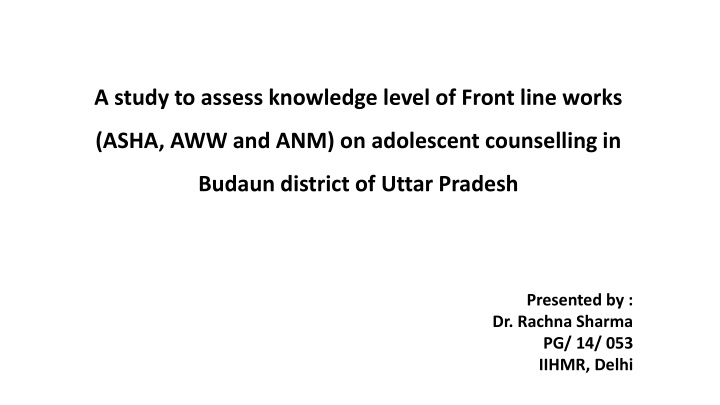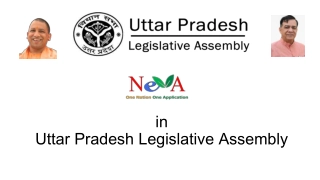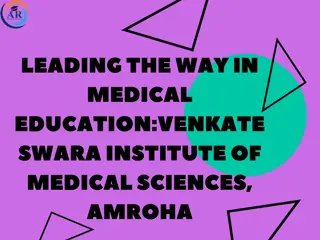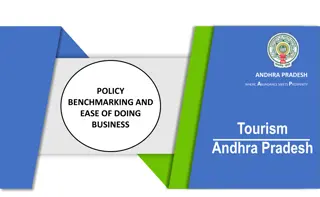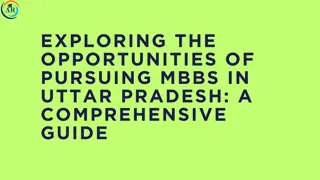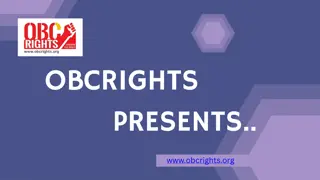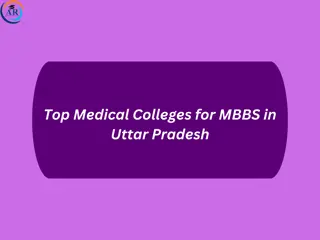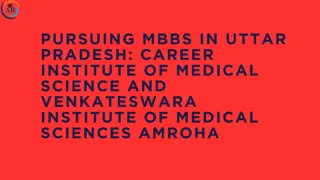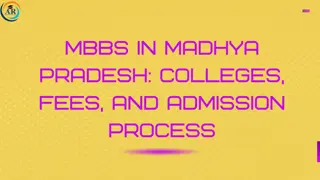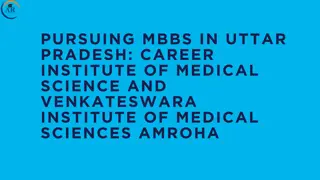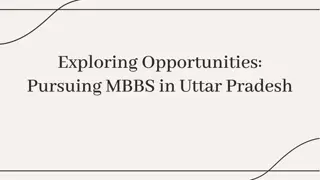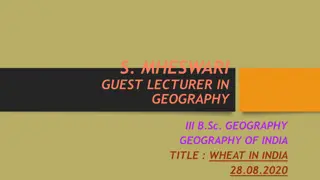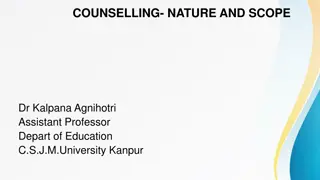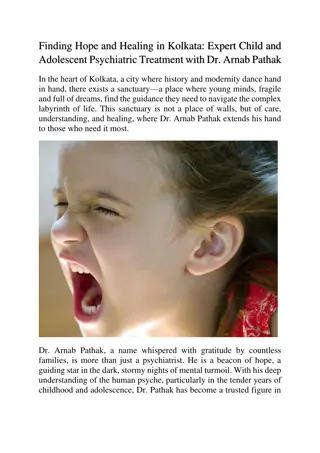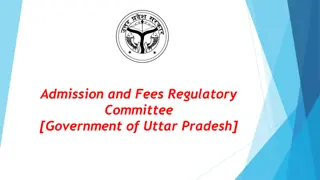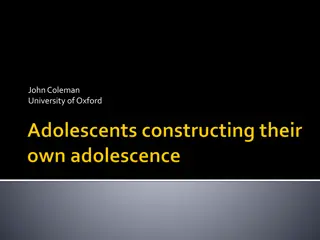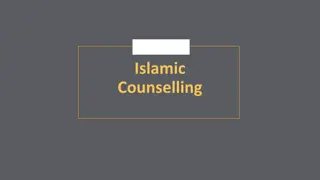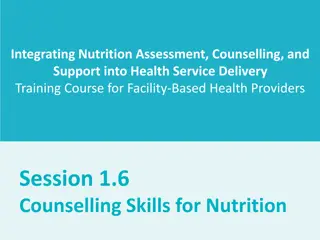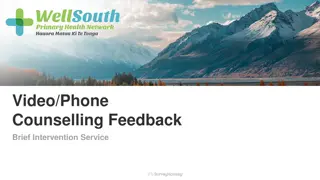Enhancing Front-line Workers' Knowledge on Adolescent Counselling in Budaun, Uttar Pradesh
A study conducted by Dr. Rachna Sharma focuses on assessing the knowledge level of front-line workers (ASHA, AWW, and ANM) on adolescent counselling in Budaun district, Uttar Pradesh. The study aims to improve the efficiency and effectiveness of key RMNCHA interventions in underserved areas, particularly in addressing poor complementary feeding practices that affect child health. The Uttar Pradesh Technical Support Unit, supported by India Health Action Trust, plays an essential role in enhancing MIYCN interventions in the region, aiming for strategic decision-making based on data. The role of the DNS in providing supportive supervision to AWWs and capacity building efforts for health and community workers is crucial in achieving the project goals.
Download Presentation

Please find below an Image/Link to download the presentation.
The content on the website is provided AS IS for your information and personal use only. It may not be sold, licensed, or shared on other websites without obtaining consent from the author.If you encounter any issues during the download, it is possible that the publisher has removed the file from their server.
You are allowed to download the files provided on this website for personal or commercial use, subject to the condition that they are used lawfully. All files are the property of their respective owners.
The content on the website is provided AS IS for your information and personal use only. It may not be sold, licensed, or shared on other websites without obtaining consent from the author.
E N D
Presentation Transcript
A study to assess knowledge level of Front line works (ASHA, AWW and ANM) on adolescent counselling in Budaun district of Uttar Pradesh Presented by : Dr. Rachna Sharma PG/ 14/ 053 IIHMR, Delhi
UTTAR PRADESH TECHNICAL SUPPORT UNIT INDIA HEALTH ACTION TRUST, UTTAR RADESH BACKGROUND A Technical Support Unit (TSU) is established for the Government of Uttar Pradesh (GoUP), with the goal of providing techno-managerial support to the GoUP to improve the efficiency, effectiveness and equity of delivery of key RMNCHA interventions. The TSU s activities will be focused on the twenty-five most underserved districts in the state, where the aim is To improve RMNCH+A service delivery and outcomes within 100 priority blocks.
The poor complementary feeding practices mean that many children continue to be vulnerable to irreversible outcomes of stunting, poor cognitive development and significant increased risk of infectious disease such as diarrhoea and pneumonia. The World Health Organization (WHO) recommends exclusive breastfeeding for the first six months of life with early initiation and continuation of breastfeeding for two years or more together with nutritionally-adequate, safe, age-appropriate complementary feeding starting at six months. WHO and UNICEF have articulated a global strategy for infant, young, child feeding. Based on these guiding principles, government of India has collaborated with international agencies to adopt the culturally acceptable IYCF guidelines which are in incorporated in Reproductive maternal neonatal and child health + adolescent program (RMNCH+A)
UTTAR PRADESHS TECHNICAL SUPPORT UNIT NUTRITION PROJECT GOAL 1: Increased ICDS capacity to delivery quality miycn interventions implementation related activities GOAL 2: Increased health system capacity to deliver quality MICYN interventions planning related activities (through gap analysis) GOAL 3: Increased use of MIYCN data for strategic decision-making
My role in organization I am working in organization as a DNS whose role and responsibility is to provide support to nutrition team in achieving all goals mentioned through Supportive supervision of AWWs in providing growth monitoring and nutrition services to the children and capacity building of health workers and community workers to implement integrated infant and young child feeding counselling and support (addressing both breastfeeding and complementary feeding). Learnings in an Organization About RMNCH+A and Nutrtion project, about MIYCN indicators and Idenification of SAM children. About health meetings, sector meetings, Functioning and structure of ICDS
RESEARCH QUESTION: What is a knowledge level of ASHA, AWW and ANM about adolescent counselling given by them? RESEARCH OBJECTIVES: To assess knowledge level of ASHA, AWW and ANM on different topics of adolescent counselling. To develop a scoring scale for knowledge assessment
METHODOLOGY Study type: Descriptive cross sectional study Study duration: February 2016 to April 2016 Study area: This study was conducted in block Ujjhani and Jagat of Badaun district of Uttar Pradesh Study respondents: ASHAs, AWWs and ANMs Sample size: Sample size is 164 which was selected through convenient sampling.
2 Blocks (1 high and 1 low delivery load block) were selected from Budaun district SAMPLING PROCEDURE: 3 clusters were selected from each block 7 or 8 Subcentres selected from each cluster Subcentre having more number of villages Subcentrer having less number of villages S 2 ASHA, 1 ANM and 2 AWW selected from each subcentre 1 ASHA, 1ANM and 1 AWW selected from each subcentre
TOOLS AND TECHNIQUES Data collection tool- An Interview schedule was used to collect the data. The data collection formats was adapted from RMNCH+A guidelines and NHM website for assessment of adolescent counselling. Data analysis tool- Excel and SPSS softwares were used for data analysis. Limitations; Observer recall bias may occur
Indicators Used to collect data of adolescent counselling to assess knowledge level of ASHA, AWW and ANM are; IFA and Albendazole distribution- About benefits of taking IFA and Albendazole and harms of nonconsumption, dosage, recognition of Anemia, reasons and symptoms of worm manifestation Menstrual hygiene- About Importance of knowledge about hygiene, how to maintain it, use of napkins etc Counselling of HIV/ STD related infectious diseases- About reasons of HIV/STD, ways to prevent, need of giving information An appropriate age of marriage ARSH clinic- About Importance of ARSH clinic, services provided by it etc Physical and mental changes during adolescent age- What are the changes, need of giving information, what type of nutrition in this age
Demographic Frequency Percent of Mean value of Information sample Knowledge distribution score 1. Age - - Mean value of Knowledge score Below 30 53 - 32.7 - 22.09 25 - - Above 30 109 - 67.2 - 22.85 24.29 24.5 24.22 24.17 24 1. Designation 23.5 - - ASHA 60 - 37.03 - 21.27 22.85 22.77 23 22.6 - - AWW 60 - 37.03 - 22.77 22.5 22.09 21.85 - - 22 ANM 42 - 25.92 - 24.29 21.7 21.59 21.38 21.27 21.5 - - Total 162 - 100 - 22.6 21 1. Education level 20.5 - - Matriculation 64 39.5 21.38 20 - - Intermediate 29 - 17.9 - 21.59 19.5 - - Graduate and 69 - 42.6 - 24.17 above 1. Last training period - - 2000- 2014 62 - 38.3 - 21.85 Mean value of Knowledge score - - 2015 44 - 27.2 - 21.7 - - 2016 55 - 33.9 - 24.22
Percent of Knowledge score in sample population Percent of Knowledge score among sample population Knowledge level Low (1- 10 satisfactory answers out of 33) 95.1 Frequency Total Percent High 3.7 2 162 1.2 Moderate Moderate (11- 18 satisfactory answers out of 33) 1.2 Low 6 162 3.7 High (more than 19 satisfactory answers out of 33) 0 10 20 30 40 50 60 70 80 90 100 156 162 95.1
ASHA AWW ANM Number of satisfactory answers 711 763 560 Knowledge of topic 1 Out of % 900 79 900 84.7 630 88.8 Number of satisfactory answers 230 241 166 Knowledge of topic 2 Out of % 360 63.8 360 66.9 252 65.8 Number of satisfactory answers 119 119 84 Knowledge of topic 3 Out of % 120 99.1 120 99.1 84 100 Number of satisfactory answers 36 63 81 Knowledge of topic 4 Out of % 180 20 180 35 126 64.2 Number of satisfactory answers 0 1 3 Knowledge of topic 5 Out of % 300 0 300 0.3 210 1.4 Number of satisfactory answers 180 179 126 Knowledge of topic 6 Out of % 180 100 180 99.4 126 100 Number of satisfactory answers 1046 1125 854 Out of % 2040 51.27 2040 55.14 1428 59.8 Overall topic knowledge
Knowledge of Front line workers for each and every topic of adolescent counselling Chart Title 120 100 100 100 99.1 100 88.8 99.4 99.1 79 80 84.7 65.8 64.2 63.8 59.8 60 51.27 66.9 35 55.14 40 20 20 1.4 0.3 0 0 IFA and Albendazole distribu. (%) Menstrual hygiene (%) An appropriate age of marraige(%) Counselling for HIV/ STD (%) ARSH clinic (%) Physical and mental changes (%) Overall Knowledge of all Topics 1 (%) ASHA AWW ANM
To Assess the knowledge level of FLWs on adolescent counselling at VHND Frequency of satisfactory answer % of satisfactory aanswers s.no Topics and subtopics Total 1 A B C D E F IFA and Albendazole distribution Benefits of giving IFA to adolescent losses of nonconsumption of IFA in adolescent Benefits of giving IFA to adolescent pregnant losses of non consumption of IFA in adolescent pregnant Symptoms of anemia in adolescents Of which colour Fe tablet should be distributed to adolescent? Of which colour Fe tablet should be distributed to Adolescent who is pregnant? What is dose of Fe tablet for an adolescent girl? What is dose of Fe tablet for an adolescent girl who is pregnant? 161 161 161 161 159 38 162 162 162 162 162 162 99.4 99.4 99.4 99.4 98.1 23.5 G 162 162 100 H I 32 159 162 162 19.8 98.1 J K L M N What is dose of Fe tablet for an adolescent girl who is an anaemic? Tablet should be taken before or after meal? Benefits of giving Albendazole to adolescent Reasons of worm infestation in adolescent girls symptoms of worm infestation in adolescent girls How many times albendazole is distributed to adolescent girls 151 157 156 137 143 162 162 162 162 162 93.2 96.9 96.3 84.6 88.3 O 96 162 59.3
2 Menstrual hygiene importance of giving menstrual hygiene related information to adolescen girls a. 162 162 100 what information should be given to adolescent girls related to mestrual hygiene b. 162 162 100 c. "Use of sanitary napkin is better than a cloth", why? 150 162 92.6 d. correct Way to use sanitary napkin 160 162 98.8 How many sanitary napkins are distributed to adolescent girls at VHND session in one month e. 2 162 1.2 Are these sanitary napkins chargable if yes then what are the selling prices? f. 1 162 0.6 3 An appropriate age of marriage a. What is an appropriate age for an adolescent girl? 162 162 100 What can be the difficulties she will face in future due to early marriage? b. 160 162 98.8
4 Counselling for H.I.V/STD related infectious diseases a. Main reason for H.I.V/ S.T.D 70 162 43.2 b. Need for giving an information regarding these infectious diseases 38 162 23.5 c. ways to prevent infection from these diseases 72 162 44.4 5 ARSH Clinic Do you know or ever heard about ARSH clinic /Kishori paraamarsh Kendra a. 2 162 1.2 b. What is an Importance of ARSH clinic? 0 162 0 c. What are services provided by an ARSH Clinic? 1 162 0.6 d. What are the topics undertaken during counselling? 1 162 0.6 e. What is a schedule or timings of ARSH clinic 0 162 0 6 Physical and Mental changes during adolescent age What are the phyisical and mental changes happen during adolescence? a. 162 162 100 Need of giving information to adolescent girls regarding phyisical and mental changes happen during adolescence? b. 161 162 99.4 What information should be given to adolescent girls regarding nutriton? c. 162 162 100
CONCLUSION: It was found that the overall knowledge was satisfactory although the data reveals a noticeable gap between the recently trained in 2016 and trained before 2015 it shows that retention of knowledge level was comparatively low. It was also found in study that knowledge level on topic of sexual infectious diseases is comparatively low as compare to other topics the reason might be social stigma Main lack of knowledge was found in areas where there was unavailability of stocks as blue Fe tablets for adolescents, Unavailability of sanitary pads and there is no ARSH clinic infrastructure. RECOMMENDATION: Unavailability of stocks should not be a ceiteria of training but training should be provided on each and every topic as per the guidelines of VHND. Advocacy for establishment of ARSH clinic is needed. IEC and BCC can be a medium to create awareness about HIV/ STDs like infectious diseases so it can be accepted by the community and it can be a part of VHND counselling then discussion of this knowledge at VHND may help in retention of this topic knowledge.
